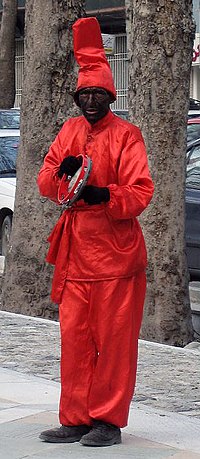Lets learn English
Don’t waste these three: Time, Money and EnergyLets learn English
Don’t waste these three: Time, Money and EnergyNowruz
[ Haji Firouz
The traditional herald of the Nowruz season is a man called Hājī Fīrūz (or Khwāja Pīrūz). He symbolizes the rebirth of the Sumerian god of sacrifice, Domuzi, who was killed at the end of each year and reborn at the beginning of the New Year.
He usually uses face paint to make his skin black and wears a red costume. Then he sings and dances through the streets with tambourines and trumpets spreading good cheer and heralds the coming of the New Year. Mehrdad Bahar, Iranologist, suggests in his book that this borrowing of the Domuzi/Tammuz tradition from the ancient non-Iranian civilizations in Mesopotamia happened with the arrival of the Iranian tribes to the western parts of the Iranian Plateau at the beginning of the 1st millennium BC. This borrowing, according to Bahar, may be true for the whole Nowruz tradition itself as Indo-Iranian tribes before that did not have this tradition while the civilizations of Mesopotamia did. This later spread to all areas where Iranian culture was present, but was lost by the non-Iranian cultures of Mesopotamia.
New Year dishes
- Sabzi Polo Mahi: The New Year's day traditional meal is called Sabzi Polo Mahi, which is rice with green herbs served with fish. The traditional seasoning for Sabzi Polo are parsley, coriander, chives, dill and fenugreek.
- Reshteh Polo: rice cooked with noodles which is said to symbolically help one succeed in life.
- Dolme Barg : A traditional dish of Azeri people, cooked just before the new year. It includes some vegetables, meat and cotyledon which have been cooked and embedded in vine leaf and cooked again. It is considered useful in reaching to wishes.
- Kookoo sabzi : Herbs and vegetable souffle, traditionally served for dinner at New Year. A light and fluffy omelet style made from parsley, dill, coriander, spinach, spring onion ends, and chives, mixed with eggs and walnut
Sizdah Bedar
The thirteenth day of the new year festival is Sizdah Bedar (literally meaning "thirteen to out", figuratively meaning "hit the outdoors on the thirteenth"). This is a day of festivity in the open, often accompanied by music and dancing, usually at family picnics.
Sizdah bedar celebrations stem from the ancient Persians' belief that the twelve constellations in the Zodiac controlled the months of the year, and each ruled the earth for a thousand years at the end of which the sky and earth collapsed in chaos. Hence Nowruz lasts twelve days and the thirteenth day represents the time of chaos when families put order aside and avoid the bad luck associated with the number thirteen by going outdoors and having picnics and parties.
At the end of the celebrations on this day, the sabzeh grown for the Haft Seen (which has symbolically collected all sickness and bad luck) is thrown into running water to exorcise the demons (divs) from the household. It is also customary for young single women to tie the leaves of the sabzeh before discarding it, so expressing a wish to be married before the next year's Sizdah Bedar. Another tradition associated with this day is Dorugh-e Sizdah, literally meaning "the lie of the thirteenth", which is the process of lying to someone and making them believe it (similar to April Fools Day)



























